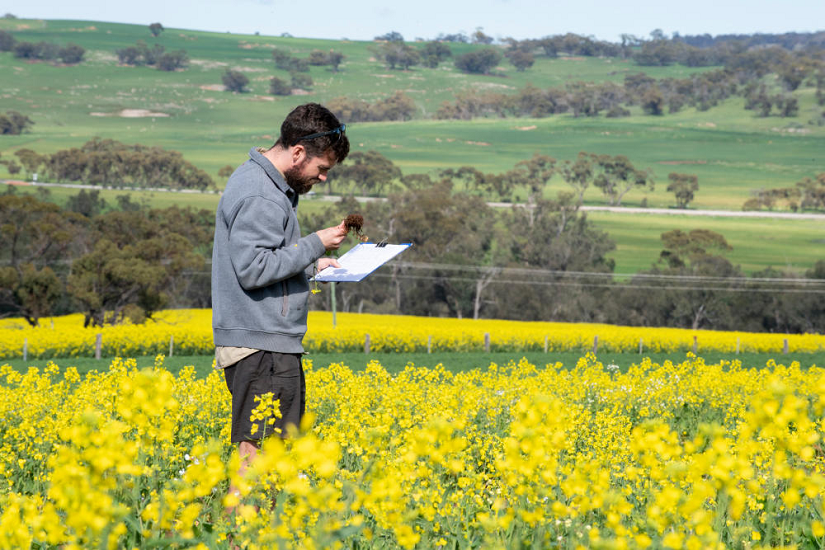
2021 has been a significant year for rainfall, creating ideal conditions for bumper grains crops – as well as pests and diseases.
The Department of Primary Industries and Regional Development (DPIRD) has harnessed its vast resources into a Season 2021 webpage to provide a one-stop-shop for information to assist grain growers navigate the crop risks as the season unfolds.
All the latest scientific research information and advice can be accessed on the department’s Season 2021 webpage, while growers can stay up to date with reports of pests and diseases via its PestFax e-newsletter.
Australian plague locusts (APL) are predicted to be active this spring, after autumn hatchings in the eastern Grainbelt and reports of damage to germinating crops in the Albany, Esperance, Kwinana East and Geraldton port zones.
Department research scientist Svetlana Micic said recent modelling suggested locusts would start hatching in the northern and eastern Grainbelt from late August and in the southern Grainbelt from mid-September.
“The immature or hopper stage locusts tend to avoid established green crops, although the edges of crops can be damaged,” she said.
“Growers with pastures who had APL present in autumn should consider control measures, if pasture is valued at the cost of replacement feed for livestock and locust numbers exceed thresholds of 20 hoppers per square metre.
“It is important to monitor paddocks closely as the weather warms up and take action if any crop damage is observed.”
DPIRD’s Season 2021 webpage has links to department advice on locust identification, control measures and spray thresholds to assist growers and other landholders.
Other pests already reported include native budworm and diamondback moth, which are expected to increase, while aphids, such as Russian wheat aphid, and armyworms, including the new fall armyworm species, will also become more active.
Mice also have potential to become a significant issue, with reports of mice activity in the Northern Agricultural Region over winter, which could pose a risk to this year’s grains harvest if not managed promptly.
DPIRD urges landholders to monitor regularly for mice activity, report observations using FeralScan’s MouseAlert app and to implement control measures immediately.
Links to further information are available on the department’s Season 2021 webpage.
Crop diseases have also started to emerge and DPIRD urges growers to monitor crops regularly and take management action to protect crop yields and grain quality.
Senior research scientist, plant pathologist Geoff Thomas, said the favourable season could result in diseases not usually seen in drier years becoming problematic.
“As the weather warms up in coming weeks crop disease management will be crucial to protect this years expected high yield potential,” he said.
“Reports of sclerotinia are widespread and DPIRD has already received several requests for information regarding control measures in canola and lupins, which could create challenges with managing the withholding periods associated with treatments.”
Mr Thomas said rust could also be an issue this season, especially for oat growers.
“There have already been reports of leaf and stem rust in wild oats and regrowth, suggesting the disease could be a risk for susceptible varieties this season,” he said.
Reports of powdery mildew affecting susceptible varieties of barley and wheat, particularly on the South Coast, indicate this crop disease could spread.
DPIRD has a range of digital decision support tools, including the MyCrop app, to assist with in paddock crop diagnosis, as well as the SclerotiniaCM, BlacklegCM, StripeRustWM, YellowSpotWN and the CropScout app to manage spray thresholds.
Growers and agronomists are encouraged to report pest and disease observations using DPIRD’s Pest Fax Reporter app to be included in the weekly PestFax newsletter, which includes PestFax Map of pest and disease occurrences throughout the Grainbelt.
The department’s Season 2021 webpage will be updated regularly as the season progresses with targeted, additional information on pests and diseases to assist growers to optimise paddock production and profitability.
While there is a lot to be optimistic about the 2021 season, DPIRD has urged landholders to remain vigilant and to act on pests and diseases to optimise crop potential.
Caption: Farmers are encouraged to vigilantly monitor crops in coming weeks for pests and diseases and to report observations via DPIRD’s PestFax Reporter app to aid regional intelligence.


